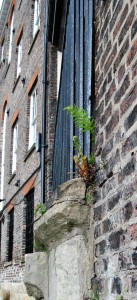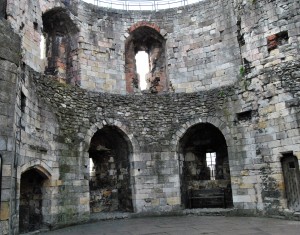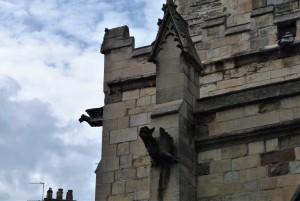![]() He thrust beyond three hundred, most bold, he cut down the centre and far wing.
He thrust beyond three hundred, most bold, he cut down the centre and far wing.
He proved worthy, leading noble men; he gave from his herd steeds for winter He brought black crows to a fort’s wall, though he was not Arthur.
He made his strength a refuge, the front line’s bulwark, Gwawrddur.
Aneirin – “Y Gododdin, Stanza 98” (c. 600.)
::::::::::::::::::::::::::::::::::::::::::::::::::::::::::::::::::::::::::::::::::::::
So I’m back again and we’ll do the normal—my Outlander help items
and then we’ll look at some of the Arthurian Legend again:
:::::::::::::::::::::::::::::::::::::::::::::::::::::::::::::::::::::::
DROUGHLANDER HELP PAGE
- Watch all the shows (both season) just paying attention to one character: i.e. Martaugh and then do it all over agan with Angus and so on…..that should take up a considerable time. https://en.wikipedia.org/wiki/List_of_Outlander_episodes

2. Keep a list–on line or by hand of all the stuff they tell you about next season….maybe break them down into categories—like Lord Gray…you could combine the listing with the watching the old shows and keep notes on the characters and if there’s any indication of characters carrying on (as in Angus Case I find that highly unlikely) http://en.yibada.com/articles/143071/20160719/outlander-seasons-3.htm
3. Worry about Jamie and Claire getting older and look up some herbals that might help them get more comfortably through their old age: http://www.inquisitr.com/3328968/outlander-star-sam-heughan-drops-major-spoilers-about-jamie-and-claires-reunion-in-season-3/

“They had at that time for their leader, Ambrosius Aurelianus, a man of worth, who alone, by chance, of the Roman nation had survived the storm, in which his parents, who were of the royal race, had perished. Under him the Britons revived, and offering battle to the victors, by the help of God, gained the victory.
![]() Bede, the Venerable – “Ecclesiastical History” (Historia Ecclesiae, 731)
Bede, the Venerable – “Ecclesiastical History” (Historia Ecclesiae, 731)
“Then it was, that the magnanimous Arthur, with all the kings and military force of Britain, fought against the Saxons. And though there were many more noble than himself, yet he was twelve times chosen their commander, and was as often conqueror.”
![]() Nennius – “History of the Britons” (Historia Brittonum, c. 829-30)
Nennius – “History of the Britons” (Historia Brittonum, c. 829-30)

ARTHUR the once and future King–according to Loomis in his book The Grail–there were by the 12th century a class of professional story tellers, who made a living telling the stories of Arthur, in fact he states it has spread as far as the Crusader states of Antioch and Palestine.
in The Dictionary of Celtic Mythoogy (Peter Berresford Ellis) says that Arthur while “Perhaps the most famous of Celtic mythological figures,…..ws undoubtedly a historical person, living in the late 5th and early 6th century and says the first reference to Arthur is by Aneirin in his poem Y Goddin, where he states he (Mynddawn Mwynfawr, was a chieftain in Scotland.
And the historical one?—Gildas (AD 500-570) concerning the ruin and conquest of Britain…and Nenniu (AD 800) who credits Arthur with 12 major victories over the invading Saxon…an a Latin history(AD 955) on his victory at Mount Badden an his death along with Medraut (Modred) at the battle of Camluan (AD 537).
The Celts (by Jean Markale)says that the historic Arthur led the stuggle against the Saxons as the personification of yet another myth, the Celtic fatherland and that only mythically did he attain supreme kingship.
Ellis goes on to say that when Malory gave him permanent form in 1496 in Morte d’Arthur he went from “Celtic chieftain, fighting against the English conquest of Britain to an English medieval king cloaked in romantic knightly chivalry”
Markale (King of the Celts) says that in the late 19th century he was viewed as an ancient god, “whose worship the Britons resumed along with other Celtic traditions in the dark ages.” But she says that this is disproved by the fact that there was never any previous note of this god which disproves this as the other gods being worshiped were historically accounted for.
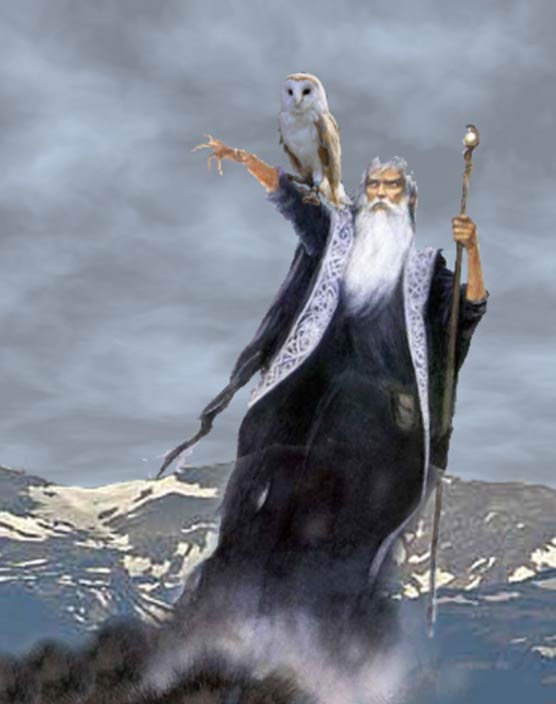
MERLIN: Mage and driving force in most of the stories. Geoffrey of Monmouth (yeah him again) states that Merlin predicted that Arthur’s life and deeds would provided a livelihood for the bards and story tellers that earned their keep on telling stories of the legendary and famous (which was mentioned under Arthur).
Roger Sherman Loomis in his The Grail From Celtic Mythic to Christian Symbol identifies Merlin with the Caledonian prophet “whom Ciraldus Cambrensis called Merlinus Celidonius.” While Ellis states he was a magician, or druid who figured prominently in the early Welsh writings and Geoffrey of Monmouth turned the bard Myrddin into Merlin, who went mad after a battle. On the other hand Markale connects Merlin “with the life of St Kntigern who came from the same area. ” Now if that’s not a lot of variation—I read somewhere–sorry I don’t remember the source–that the author felt that Merlin was actually an early Christian Bishop (not Catholic for at this time the Celtic church was separate and had several beliefs separating them from the Catholic beliefs….it was only later that they agreed to adjust and come under the control of the Roman Church.)

L
Loomis says that the name Lancelot was influenced by the name Lancelin from Brittany (1034) and he credits the Bretons for spreading the legends throughout the French speaking world. He also states that Kulhwn’s(Welsh 1100) story may have been heavily borrowed from (like convention speeches today) by a French writer Chretien (1160) who reportedly changed the Welsh Llenlleawc to the French Lancelot.
Malory (13th book) gives an account of Lancelot’s repentance and confession which according to Loomis is directly from a sermon by the Monk of Clairvaux.
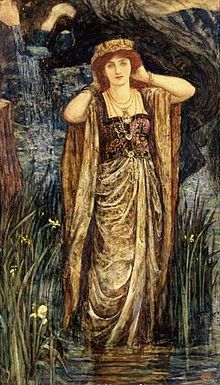
GUENEVERE: The king’s faithless wife and the 3rd side of the triangle of betrayal and the failure of the legend. Loomis points out that in the Welsh tales she was Gwenhwyvar (means white ghost or white spirit), while in Chretien she becomes Guenievere. He also attributes the origin of the abductions of Guenevere which appeared in multiple accounts as originating in Ireland.
Ellis states “she has her counterparts in Helen of Troy…her beauty and abduction bringing betrayal, war and ultimate disaster.
Markale says that the name is spelled in several different versions but that the root word is gwen
which has four meanings
First “white and thus beautiful, since white and beauty were synonymous among the Celts
Then it came to mean blonde
and finally as white and blonde which were all thought to be characteristic of the high-born, (a word used to mean well-bred or those of pure blood.)
In Brittany (still Markale) it was even used to mean saintly in a Christian sense.
Interestingly enough in one of the Histories Guinevere is kidnapped (see more under Modred) and because it is felt she is compliant with her abductor, her former lover Lancelot kills her.
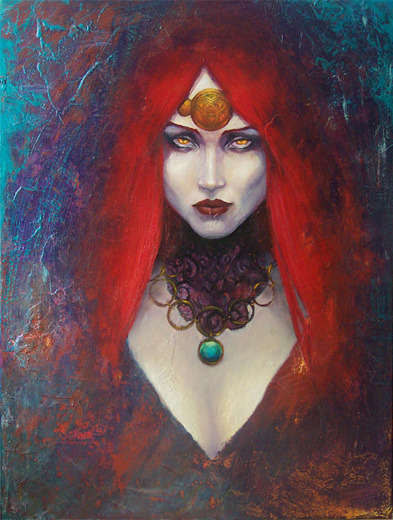
MORGAN LE FAY: Arthur’s half sister and a popular character to place much evil and blame upon. Loomis points out that her character is varied and she “may be the most beautiful of nine sister enchantresses and nurse to her brother Arthur in Avalon, or she may be an ugly crone who plots his death.” He goes on to say “…though Morgan le Fay has precisely the family relationship of the Welsh Modron and is therefore like her, descended from the Celtic goddess Matrona and is in fact called a goddess in four medieval texts,…..generally presented in Arthurian romance as a benevolent or malevolent enchantress.” And he notes that there is no attribute of Morgan’s better authenticated than her power of healing.
While in Mallory she is Arthur’s half sister, by his mother Igraine’s first marriage, in the Vulgate Merlin and the Huth-Merlin she is his niece, the daughter of King Lot. According to Coghan’s Illustrated Encyclopedia of Arthurian Legends she learned most of her magi from Merlin and depending on the story she was in love with another of Arthur’s nephews, Guiomar but ended marrying Urien, while in another she tried to have her lover (Accolon of Gaul) kill Arthur. And somewhere in the midst of all that she fell in love with Lancelot, but he escaped and she still had time to help bare Arthur off on a barge after his final battle.
Cohan feel that she originated from the goddess Modron. Even in Sir Gawain and the Green Knight she is called “Morgan the goddess.”

In early Welsh stories Modred married and had two sons and he seems to have been regarded as a hero rather than a villain
While one legend says that Modred was the incestuous, illegitimate son of Arthur and Morgan, Geoffrey says that Mordred was the son of Arthur’s sister Anna and her husband, Lot. In Dream of Rhonabwy he is Arthurs Nephew and foster son.
Malory added the incest angle to Mordred’s birth, with Arthur sleeping with Morgana, with out knowing they were related
Geoffrey tells that Modred seized Guinevere and the throne while Arthur was away on a campaign (or in Mallory’s account while Arthur went to fight Lancelot), which all ended at Camlann.
In later tales Arthur becomes symbolic of Christianty who is defeated at Camlaan by the forces of evil in the shape of Arthur’s nephew Mordret (Mordred) the ally of the heathen Saxons and Irish. (Markdale). In fact the final duel to the death produces no victor and both Arthur and his nephew (and illegitimate son) die at the battle.
Like Morgana, Mordred’s legends are sorted. In Annales Cambriae it is recorded that both Arthur and Medrawt (Mordred) perished at Camlann….but never does it say they weren’t on the same side.
While Ly Myreur de Histories advises that Modred survived the battle but was defeated by Lancelot (whom he was friends with in the Malory stories)and thrown into a cell with the body of Guinevere–he eventually starves to death (but not before he dines on the corpse of the late queen).
::::::::::::::::::::::::::::::::::::::::::::::::::::::::::::::::::::::
“The valiant Arthur, who was at that time the commander of the soldiers and kings of Britain, fought against [the invaders] invincibly. Twelve times he led in battle. Twelve times was he victorious in battle. The twelfth and hardest battle that Arthur fought against the Saxons was on Mount Badon, where 440 of his men died in the attack that day, and no Briton stayed to support him, the Lord alone strengthening him.”
Henry of Huntingdon – “History of the English” (Historia Anglorum, c. 1130)
“And even the renowned king Arthur himself was mortally wounded; and being carried thence to the isle of Avalon to be cured of his wounds, he gave up the crown of Britain to his kinsman Constantine, the son of Cador, duke of Cornwall, in the five hundred and forty-second year of our Lord’s incarnation.”
Geoffrey of Monmouth – “History of the Kings of Britain” (Historia Regum Britanniae; c. 1136)
All pictures are still from York

